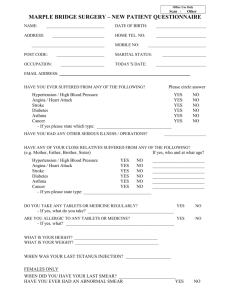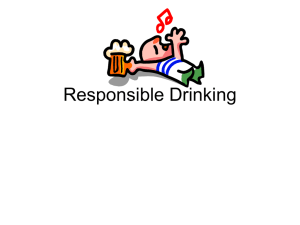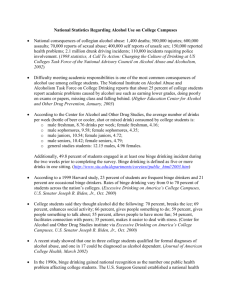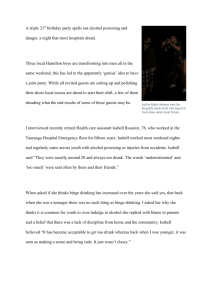Persuasive Speech Materials Packet
advertisement
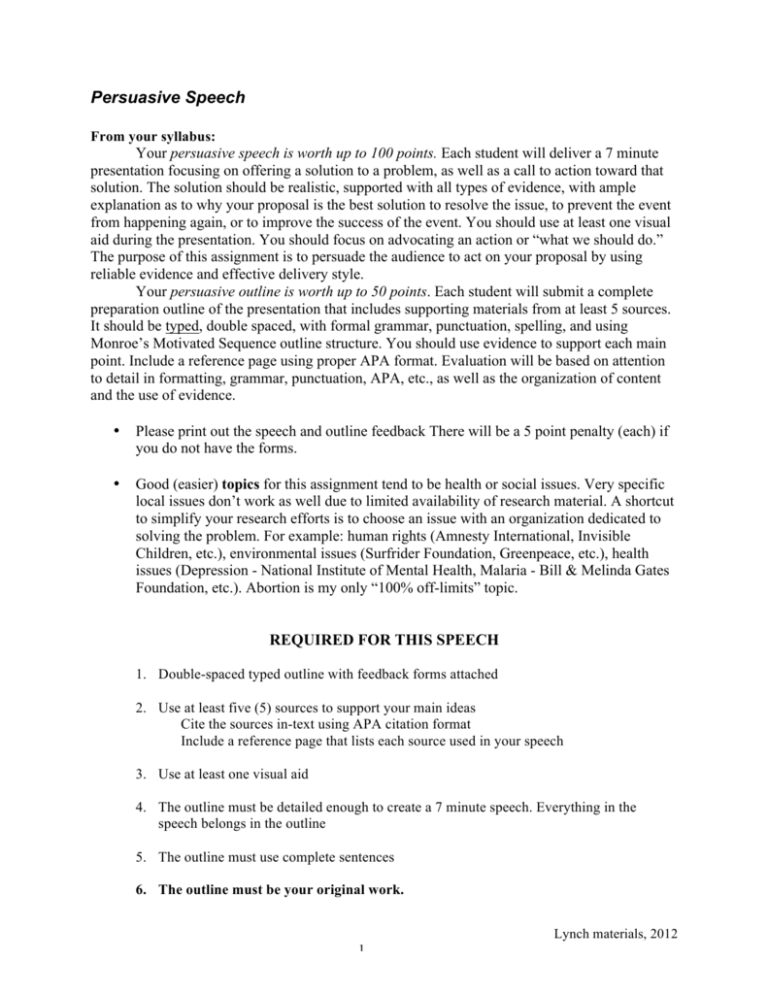
Persuasive Speech From your syllabus: Your persuasive speech is worth up to 100 points. Each student will deliver a 7 minute presentation focusing on offering a solution to a problem, as well as a call to action toward that solution. The solution should be realistic, supported with all types of evidence, with ample explanation as to why your proposal is the best solution to resolve the issue, to prevent the event from happening again, or to improve the success of the event. You should use at least one visual aid during the presentation. You should focus on advocating an action or “what we should do.” The purpose of this assignment is to persuade the audience to act on your proposal by using reliable evidence and effective delivery style. Your persuasive outline is worth up to 50 points. Each student will submit a complete preparation outline of the presentation that includes supporting materials from at least 5 sources. It should be typed, double spaced, with formal grammar, punctuation, spelling, and using Monroe’s Motivated Sequence outline structure. You should use evidence to support each main point. Include a reference page using proper APA format. Evaluation will be based on attention to detail in formatting, grammar, punctuation, APA, etc., as well as the organization of content and the use of evidence. • Please print out the speech and outline feedback There will be a 5 point penalty (each) if you do not have the forms. • Good (easier) topics for this assignment tend to be health or social issues. Very specific local issues don’t work as well due to limited availability of research material. A shortcut to simplify your research efforts is to choose an issue with an organization dedicated to solving the problem. For example: human rights (Amnesty International, Invisible Children, etc.), environmental issues (Surfrider Foundation, Greenpeace, etc.), health issues (Depression - National Institute of Mental Health, Malaria - Bill & Melinda Gates Foundation, etc.). Abortion is my only “100% off-limits” topic. REQUIRED FOR THIS SPEECH 1. Double-spaced typed outline with feedback forms attached 2. Use at least five (5) sources to support your main ideas Cite the sources in-text using APA citation format Include a reference page that lists each source used in your speech 3. Use at least one visual aid 4. The outline must be detailed enough to create a 7 minute speech. Everything in the speech belongs in the outline 5. The outline must use complete sentences 6. The outline must be your original work. Lynch materials, 2012 1 Persuasive Feedback Form - Speech 100 points possible POOR Style Professional attire/attitude Initial and derived credibility, poise/confidence FAIR AVERAGE GOOD EXCELLENT X X X X X X X X X X X X X X X Facial expressions Natural, enhanced meaning, and added interest X X X X X Stance Confident and relaxed (not frozen, nor swaying) Movement reinforced message being expressed X X X X X X X X X X Gestures Relaxed and natural (not repetitive) X X X X X Vocal variety Talked to the audience (not at them) Natural, conversational tone X X X X X X X X X X Delivery Appropriate use of pauses, good overall pace AVOIDED use of non-words Spoke with energy and conviction X X X X X X X X X X X X X X X Use of Notecards AVOIDED reading, cards were not distracting X X X X X Content Introduction (Attention Step) Interesting/creative attention getter Met all objectives clearly and flowed smoothly X X X X X X X X X X Explanation(s) Thought organization was clear and easy to follow Information was relevant to speech X X X X X X X X X X Transitions Smooth and helpful to audience X X X X X Action Step Met all objectives clearly and effectively Good closure – neither abrupt nor drawn out X X X X X X X X X X Language Vivid and appropriate to audience level X X X X X Visual Aid Smooth (followed guidelines discussed in class) Professional appearance, easy to see and read X X X X X X X X X X Eye contact Direct and sustained (did not stare into space or look over people’s heads) Eye contact built rapport with entire audience Time management Final score did not reach required time / within limits / exceeded limits _________/100 Lynch materials, 2012 2 Persuasive Feedback Form - Outline 50 points possible Purpose & Thesis statements (1) Attention Step Attention getter Reason to Listen/State topic Speaker credibility Preview of main points (4) Need, Satisfaction & Visualization Steps Clear & organized Organization follows Monroe’s Motivated Sequence (10) Quality of evidence/arguments – are the types used appropriate and effective? Example Statistics Quotations Analogies (12) Action Step Review main points Statement of Action or Attitude Change Statement of Personal Intent Ended with impact (3) Format/Organization/Structure Title page, stapled, double spaced, proper outline subordination and format, complete sentences, logical “flow” of information, proofread for errors… (15) APA format In text citations Reference page (5) Total ________/50 Lynch materials, 2012 3 Support Materials Persuasive Speech Guide for Planning a Persuasive Speech Using Monroe’s Motivated Sequence I. Attention Step A. Attention Getter An illustration or story A startling statement A quotation A rhetorical question A reference to the subject B. Reason to Listen (and clearly state your topic) Motivate your audience’s interest in your subject. Tell them about the practical value of your information in their lives. C. Speaker Credibility Alluding to any first-hand experience you may have had with your topic. Alluding to sources of information you have consulted on your topic. D. Preview Main points Briefly describe what you will cover, and the order in which it will be discussed. Define any technical terms you will be using. II. Need Step (Note: There are two types of needs, your speech uses one. You will either (1) urge a change by pointing out what is wrong with present conditions; or (2) demand preservation of present conditions by pointing out the danger of a change). A. State the Need State what is wrong with present conditions OR State why change would be wrong B. Illustration Tell us of one or more incidents to illustrate the need. C. Ramifications Employ as many additional facts, examples, and quotations as are required to make the need convincingly impressive. D. Pointing Show the importance of the need specifically to the members of your audience. Transition: “Now that I’ve explained the problem, let me move on to my proposed solution.” III. Solution Step A. Statement of Solution Briefly state the belief, attitude, value, or behavior change you wish your audience to adopt. Lynch materials, 2012 4 B. Explanation of Solution Explain the details of you solution. Make sure your proposal is understood. C. Theoretical Demonstration Show how your solution logically and adequately meets the needs as presented in the need step. Approach this in a point by point fashion. D. Practical Experience Provide actual examples of where this solution has been tried and is working to solve the need, or where this belief has been proven to be correct. If the solution has never been tried before, use an analogy to compare your solution with a similar solution that was effective. E. Meeting Objections Address the claims of the opposition, and present your arguments against them. Forestall opposition to your proposal by overcoming any objections that might be raised. Transition: Use a transitional device to indicate a move from your Solution Step t your Picture Step. IV. Picture Step A. Negative Picture As realistically as possible, describe the conditions if your solution is not carried out. Picture the audience feeling the bad effects or unpleasantness that the failure to effect your solution will produce. B. Positive Picture As realistically as possible, describe the conditions if your solution is carried out. Picture the listeners in that situation actually enjoying the safety, pleasure, or pride that our proposal will produce if accepted. V. Action Step A. Restate Main Points Briefly review the main points you covered in your speech. B. Statement of Action or Attitude Change Specifically tell your audience what it is you want them to do now. C. Personal Intent Make a declaration to your audience about what it is you plan to do to further your solution. D. Reason to Remember/Tie Back to Introduction Somehow refer to your attention getter. Provide your audience with a reason to remember your speech Lynch materials, 2012 5 Sample Skeleton of Persuasive Outline (Monroe’s Motivated Sequence) Title: __________________________________________________________________ General Purpose: ________________________________________________________ Specific Purpose: ________________________________________________________ Thesis Statement: ________________________________________________________ I. Attention Step A. Attention Getter _________________________________________________________ B. Relate to the Audience _____________________________________________________ C. Speaker Credibility _______________________________________________________ D. Preview of Main Points ____________________________________________________ II. Need Step A. Statement of Need ________________________________________________________ B. Illustration ______________________________________________________________ C. Ramifications 1. ____________________________________________________________________ 2. ____________________________________________________________________ 3. _____________________________________________________________________ D. Pointing ________________________________________________________________ Transition: ____________________________________________________________________ III. Satisfaction Step A. Statement of Solution ______________________________________________________ B. Explanation of Solution ____________________________________________________ C. Theoretical Demonstration __________________________________________________ 1. ____________________________________________________________________ 2. ____________________________________________________________________ 3. _____________________________________________________________________ D. Practical Experience _______________________________________________________ E. Meeting Objections _______________________________________________________ 1. (Objection) ___________________________________________________________ a. (Rebuttal to objection) _______________________________________________ 2. (Objection) ___________________________________________________________ a. (Rebuttal to objection) _______________________________________________ Lynch materials, 2012 6 Transition: ____________________________________________________________________ IV. Picture Step A. Negative Picture _________________________________________________________ B. Positive Picture __________________________________________________________ V. Action Step A. Restate Main Points ________________________________________ B. Statement of Specific Action or Attitude Change ________________________________ C. Statement of Personal Interest ______________________________________________ D. Reason to Remember ______________________________________________________ Lynch materials, 2012 7 (Sample Persuasive Outline) Binge Drinking (Student Name) GEO 102: Lynch (Date speech/outline due) Lynch materials, 2012 8 General Purpose: To persuade. Specific Purpose: To persuade my audience to stop binge drinking. Thesis Statement: To persuade my audience, through exploration of the problem, my solution and possible outcomes, to take an stand against binge drinking. I. Attention Step A. (attention getter) On Labor Day weekend back in 2004, 19 year old Sam Spady, a sophomore at Colorado State University was found dead in a fraternity house after a night of binge drinking (Death by Alcohol, 2006). B. (topic/reason to listen): Today I will be talking about binge drinking. You will all want to listen because binge drinking is at its highest in our age group and I will be offering a solution today. C. (credibility) For the past six weeks I have been studying and researching the topic of binge drinking and in my eighteen years on this earth I have been around binge drinkers. D. (Preview): In the next six minutes I will present to you: 1. The problem of binge drinking. 2. My solution to the problem of binge drinking. 3. I will show you a picture of the positive and negative sides to my solution. 4. Then I will ask you to take action against binge drinking. Transition: Now let’s get started. II. Need Step A. (statement of need): As many of you now know, binge drinking is a serious problem especially among college students. B. (illustration) Let’s go back to Colorado, to the University of Colorado this time. In Lynch materials, 2012 9 September 2010, fraternity pledges were brought to a table with 6 bottles of liquor and 6 bottles of wine, then given a half an hour to finish them. One of the students was Gordie Bailey and he was 18 years old. In the call to 911 the next day someone said “We got a guy is passed out. He drank way too much and we found him this morning.” Gordie had passed the university’s alcohol awareness course with a 96%, then drank himself to death less than a month later (Dakss, 2010, p. 1). C. (ramifications) There is also other evidence that binge drinking continues to be a problem in the world and most importantly on college campuses. 1. Dateline NBC did a story on binge drinking at the University of Colorado. They interviewed a few students one of which was a junior named Nick Hanson majoring in marketing. Nick drinks about fifteen to twenty drinks a night often several times a week. He also stated that he will consume up to ten beers before he even goes out (College binge drinking, 2003). 2. Lily was a senior at the university celebrating her 21st birthday. The ritual at the school was to have 21 drinks, she quickly lost count on which drink she was on, the reporters were not sure whether or not she was drunk and she told them “that’s because I drink like a guy and I can hold my liquor.” (College binge drinking, 2003). 3. Like I already said learn about alcoholism.com tells me that binge drinking is most common between ages 18 and 22 and that two-thirds of alcohol consumed by college students is consumed by binge drinkers (Mogul, n.d.). 4. Also stated in one of my pervious speeches about 60% of all problems with the police on college campuses (such as injuries, vandalism, etc.) involve binge drinkers (Mongul, n.d.). Lynch materials, 2012 10 D. (pointing) A student at San Marcos High School named Scott Roberts died in 2009 from binge drinking. He had 24 markings on him indicating that he had had 24 shots. Although he is not a college student he is still a student just like the rest of us and this tragedy that he and his family faced is a very real issue to us all (Gordon, 2009). Transition: This brings me to my solution. III. Satisfaction step A. (statement of solution) The solution to binge drinking is not to binge drink. B. (explanation) You may be sitting there thinking “well, duh” that’s the solution but let me explain some more. 1. Like I have previously stated binge drinking to men is five alcoholic beverages in a two hour period. For women, its four alcoholic beverages in a two hour period (Poncelet, 2009). 2. The solution I am presenting to you all is merely stating that when you are out drinking or in a social environment you will drink moderately meaning only one or two drinks within the two hour period. a. I have come up with a saying to help people realize when they have had close to too many drinks so they can quit while they are ahead. (1,2,3, that’s enough for me!) C. (theoretical demonstration) Here’s how my motto would work. 1. A student would go to a fraternity party with the intentions to drink but not get wasted like they normally would. They arrive at the party where everyone is just getting started so they take one drink. A few moments later there are on to their next drink. Just before you know it they hit three drinks and then someone hands them another at this point the student reminds themselves of 1,2,3 that’s enough Lynch materials, 2012 11 for me and they stop drinking. 2. This example can very easily happen, a student just needs to know what’s best for them and to stay strong under peer pressure. D. (Practical Experience) Using this method of thinking can help students and adults. 1. Remember Nick Hansen from the beginning of my speech? Well Nick decided that he didn’t want to get wasted anymore so he cut back on his drinking. He now only drinks moderately. 2. Gordie Bailey of the University of Colorado might still be alive today if his fraternity hadn’t pressured him to drink more than he knew was good for him. Following the guidelines of their alcohol awareness program would have prevented this tragedy. 3. Think of this solution/saying as getting seconds at dinner after two rounds normally you are full and you can’t consume anymore so you stop yourself. E.(Meeting Objections) There may be some objections to my solution 1. Some people might say this isn’t going to stop people from binge drinking. a. What I can say to prove this wrong is that if someone wants to change they can. You must believe in yourself and have support and you can do it. Like getting over a sickness all you do is strive to get better. 2. Others might say that I am trying to stop drinking all together. a. This is completely untrue. I am not telling you to stop drinking all together I am simply asking that you stay away from binge drinking and drink moderately. Transition: Now I will show you a picture of what my solution will look like. IV. Picture Step Lynch materials, 2012 12 A. (Negative picture) This is a picture of what can happen to you and everyone around you if you binge drink. These people never got to experience their full life span because they died. B. (positive picture) Now here is a picture of what life will look like if we use my solution. Life is happy and great! V. Action Step A. (restate main points) Today I have talked about the problem of binge drinking, I have offered you a solution and I have shown you pictures of what life would be like with and without my solution. B. (statement of action or attitude change) Now I would like you all to take action. Avoid being a binge drinker by following my saying the next time you go out to drink (“1, 2, 3, that’s enough for me”). And if you don’t drink, I ask you to be a support system for your friends. Be an advocate in spreading the word on binge drinking. C. (statement of personal intent) This brings me to what I am going to do. I am going to continue to be a support system to those around me and I am going to continue to bring awareness on the topic of binge drinking. Lynch materials, 2012 13 D. (reason to remember) I hope that you remember what you heard today because binge drinking is a serious problem. I don’t want CSUSM to make headlines when the solution is so easy. Lynch materials, 2012 14 References College binge drinking, Administrators struggle with student alcohol consumption . (2003, October 26). In Dateline NBC on Dateline. Retrieved November 19, 2011, from http://www.msnbc.msn.com/id/3088196/ns/dateline_nbc/t/college-binge-drinking/. Dakss, B. (2010, March 1). Binge Drinking Turning Deadly. In CBS News. Retrieved November 20, 2011, from http://www.cbsnews.com/2100-500172_162-649375.html. 'Death by Alcohol' Warns of College Binge Drinking Risks. (2006, June 12). In ABC News. Retrieved November 19, 2011, from http://abcnews.go.com/GMA/Health/story?id=2065494&page=1. Gordon, S. (2009, June 26). CARLSBAD: Boy who died after drinking was a San Marocs Student. In North County Times. Retrieved November 22, 2011, from http://www.nctimes.com/news/local/carlsbad/article_5c93a17e-acf4-5f1f-949427f418d19f9b.html. Mogul, S. (n.d.). Binge Drinking Statistics. In Learn-About-Alcoholism.com. Retrieved November 22, 2011, from http://www.learn-about-alcoholism.com/binge-drinkingstatistics.html. Poncelet, B. (2009, September 4). Binge Drinking. In About.com. Retrieved November 22, 2011, from http://teenhealth.about.com/od/glossary/g/bingedrinkingdef.htm. Lynch materials, 2012 15


